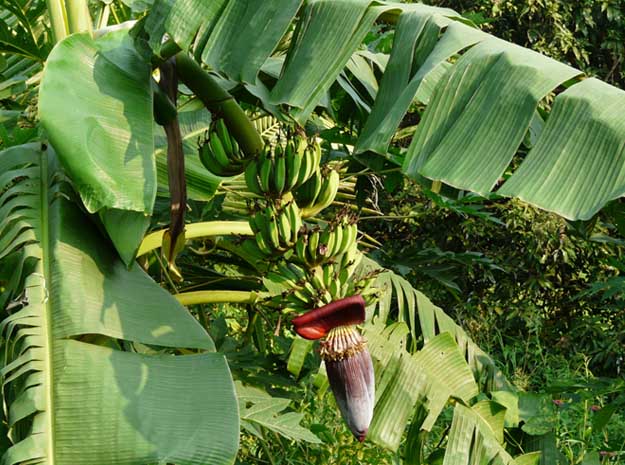
Banana
Genus: Musa
Botanical name: Musa paradisiaca
PLANT NAME IN DIFFERENT LANGUAGES
Sanskrit: Bhanuphala, Kadali, Mocha
Hindi: Kela
English: Banana
Malayalam: Vazha, Vaazha
MEDICINAL PROPERTIES
Almost all cultivated plantains and many cultivated bananas are triploid cultivars of Vazha. It is believed that Southeast Asian farmers first domesticated M. acuminata. When the cultivated plants spread north-west into areas where M. balbisiana was native (see map), hybrids between the two species occurred and were then developed further into a wide range of cultivars.
Hundreds of cultivars of Banana, are known, possessing characteristics that are very variable, but broadly intermediate between the ancestral species. They are typically 2–9 metres (7–30 ft) tall when mature. The above-ground part of the plant is a “false stem” or pseudostem, consisting of leaves and their fused bases. Each pseudostem can produce a single flowering stem. After fruiting, the pseudostem dies, but offshoots may develop from the base of the plant. Cultivars of Vazha, are usually sterile, without seeds or viable pollen.
The whole parts of the Banana plant have medicinal applications: the flowers in bronchitis dysentery and on ulcers; cooked flowers are given to diabetics; the astringent plant sap in cases of hysteria, epilepsy, leprosy, fevers, hemorrhages, acute dysentery and diarrhea, and it is applied on hemorrhoids, insect and other stings and bites; young leaves are placed as poultices on burns and other skin afflictions; the astringent ashes of the unripe peel and of the leaves are taken in dysentery and diarrhea and used for treating malignant ulcers; the roots are administered in digestive disorders, dysentery and other ailments; banana seed mucilage is given in cases of diarrhea in India. Antifungal and antibiotic principles are found in the peel and pulp of fully ripe bananas. The antibiotic acts against Mycobacteria. A fungicide in the peel and pulp of green fruits is active against a fungus disease of tomato plants. Norepinephrine, dopamine, and serotonin are also present in the ripe peel and pulp. The first two elevate blood pressure; serotonin inhibits gastric secretion and stimulates the smooth muscle of the intestines.
